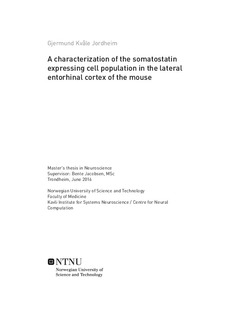| dc.description.abstract | The lateral entorhinal cortex is a part of the parahippocampal region, and has received attention for being involved in object and object characterization task, hence conveying nonspatial input to the hippocampal formation. In order to fully comprehend the functional role of the lateral entorhinal cortex, an important step is to understand the function of its local micro circuitry. Interneurons have been strongly implemented in the functioning of cortical networks. However, little is known concerning the interneurons in the lateral entorhinal cortex.
The aim of this thesis was to characterize the distribution of somatostatin cells in the lateral entorhinal cortex, and to look at their monosynaptic inputs. For the distribution analysis we injected an adeno-associated helper virus into the lateral entorhinal cortex of somatostatin- Cre mice. In our monosynaptic tracing experiments, we injected both adeno-associated helper virus and a G-deleted rabies virus into the lateral entorhinal cortex in our transgenic mouse line. We tested several viral strategies to optimize the viral tracing protocol. Cresyl Violet stained sections were used to delineate brain areas. Viral tracers were visualized either by the expression of fluorescent proteins or immunohistochemically enhanced with AlexaFluor dyes. The tissue was subsequently analyzed by using traditional microscopical techniques.
After testing several viral injections strategies, we found that the most optimal strategy involved separate injections of virus, separated by a sufficient incubation period which serves to ensure the framework for viral transport. The results from the monosynaptic viral tracing experiments showed that the somatostatin cells in the lateral entorhinal cortex have a strong intrinsic connectivity within the LEC, but also receive a substantial amount of input from extrinsic sources. Our distribution analysis showed that the majority of somatostatin cells are situated in deeper layers of the lateral entorhinal cortex, and that they are evenly distributed throughout the dorsoventral axis. | nb_NO |
